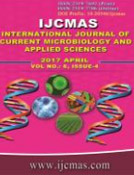


 National Academy of Agricultural Sciences (NAAS)
National Academy of Agricultural Sciences (NAAS)

|
PRINT ISSN : 2319-7692
Online ISSN : 2319-7706 Issues : 12 per year Publisher : Excellent Publishers Email : editorijcmas@gmail.com / submit@ijcmas.com Editor-in-chief: Dr.M.Prakash Index Copernicus ICV 2018: 95.39 NAAS RATING 2020: 5.38 |
Distributions of different zinc (Zn) forms in seven blocks of rice-wheat growing soils of Jammu region were studied. Understanding the Zn distribution in soil is important for efficient and effective management of the fertilizers recourses and to achieve a higher productivity rate. Sequential extraction scheme was used to fractionate Zn into Water Soluble + Exchangeable (WSEX), Organic Complexed (OCx), Amorphous sesquioxide (AMOX), Crystalline Sesquioxide (CRYoX) and Residual zinc (Res Zn). Total zinc (T Zn) was calculated as the sum of all the pools and it ranged between 18.31-64.59 with an average of 43.94 mg kg-1. The distribution of Zn in the soils on the basis of average concentrations was in the order 34.32 mg kg-1 Res Zn (78%)> 4.82 mg kg-1 OCx (11%) > 3.39 mg kg-1 AMOX (8%)> 0.89 mg kg-1 CRYoX (2%)> 0.52 mg kg-1 WSEX (1%). Percentage of potentially available Zn fraction was highest in Bishna block (26.57%) and lowest in Hiranagar block (11.48%). Correlation analysis (n=55) showed all the fractions were significantly negatively correlated with pH except for OCx, while as a positive relation with electrical conductivity (EC), organic carbon (OC) and clay content.
 |
 |
 |
 |
 |